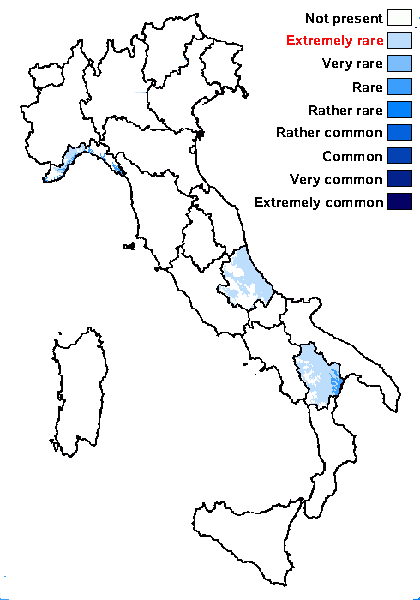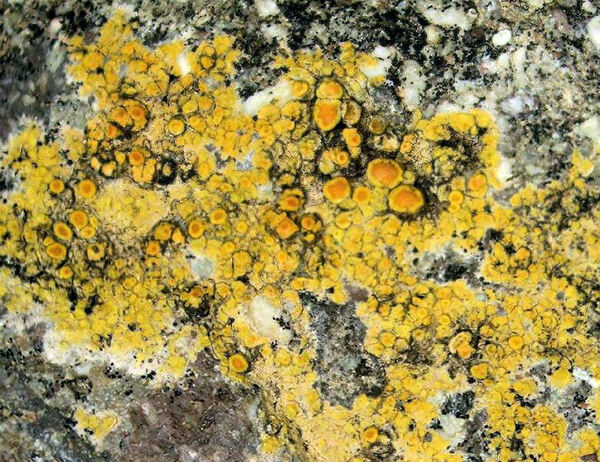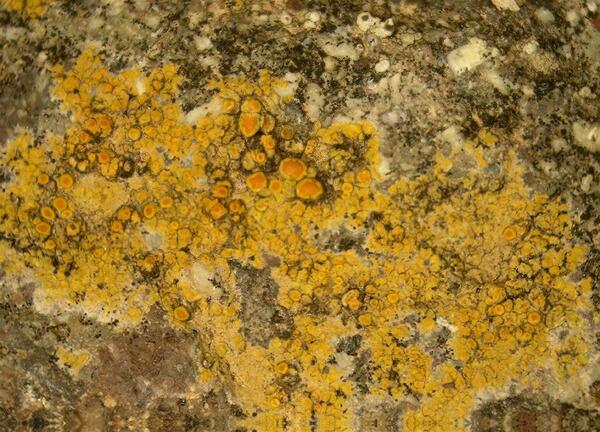Xanthocarpia diffusa (Vondrák & Llimona) Frödén, Arup & Søchting
in Arup & al., Nord. J. Bot, 31: 57, 2013. Basionym: Caloplaca diffusa Vondrák & Llimona - Lichenologist 43: 471, 2011.
Synonyms: Caloplaca prinii B. de Lesd.
Distribution: N - Lig (TSB 34395). C - Abr (TSB 26990). S - Bas (TSB 29718).
Description: Thallus crustose, episubstratic, areolate, yellow, ochre-yellow or grey-yellow, forming patches to several cm in diam., the marginal parts diffuse, often delimited by a pale prothalline line. Areoles angular, 0.17-0.7(-1.1) mm wide, to 150 µm thick. True cortex absent, but a thin alveolate cortex (sensu Vondrák & al. 2009) sometimes present, up to 20 µm thick; medulla poorly evident. Apothecia zeorine, 0.4-0.7(-1) mm across, with a pale to dark orange disc and an often crenulate thalline margin. Thalline exciple(60-)80-125(-150) µm thick; proper exciple with yellow-orange granules, (30-)40-120(-150) µm thick, the upper part of isodiametrical, 5-7 µm wide cells, the lower part prosoplectenchymatous; hymenium colourless, 70-90 µm high; paraphyses branched, the apical cells 3.5-5.7 µm wide; hypothecium colourless. Asci 8-spored, clavate, functionally unitunicate, apically thickened with a broad internal beak, the inner part of apex and external cap I+ blue, Teloschistes-type. Ascospores 2-celled, polarilocular, (11-)14-16.5(-17.5) x (5-)6-8(-9) µm, the equatorial thickening (“septum”) 2-3.5 µm. Pycnidia indistinct or forming orange spots. Conidia narrowly ellipsoid to short-bacilliform,. 2.7-3.2 x 1-1.7 µm. Photobiont chlorococcoid. Spot tests: thallus and apothecia K+ red, C-, KC-, P-, UV+ orange. Chemistry: thallus and apothecia with parietin (major), fallacinal, emodin, teloschistin and parietinic acid (minor), corresponding with chemosyndrome A of Søchting (1997). Note: on base-rich siliceous rocks. According to Roux & coll. (2014) the type of Caloplaca prinii B. de Lesd. belongs to this species: the latter name having priority a new combination would be required if the synonymy will be confirmed by molecular data. See also note on X. crenulatella.
Growth form: Crustose
Substrata: rocks
Photobiont: green algae other than Trentepohlia
Reproductive strategy: mainly sexual
Commonnes-rarity: (info)
Alpine belt: absent
Subalpine belt: absent
Oromediterranean belt: absent
Montane belt: absent
Submediterranean belt: extremely rare
Padanian area: absent
Humid submediterranean belt: absent
Humid mediterranean belt: rare
Dry mediterranean belt: rare

Predictive model
Growth form: Crustose
Substrata: rocks
Photobiont: green algae other than Trentepohlia
Reproductive strategy: mainly sexual
Commonnes-rarity: (info)
Alpine belt: absent
Subalpine belt: absent
Oromediterranean belt: absent
Montane belt: absent
Submediterranean belt: extremely rare
Padanian area: absent
Humid submediterranean belt: absent
Humid mediterranean belt: rare
Dry mediterranean belt: rare

Predictive model
 INDEX FUNGORUM
INDEX FUNGORUM
 GBIF
GBIF



